Crawling Back: Amazing Spider-Man #96-98 Review (The Osborn Prelude, Part 7)
Artistically and narratively, Lee and Kane deliver a surprisingly poignant trilogy, providing commentary on a real world problem through the long-running enmity of arch-enemies
—by Nathan on September 2, 2024—
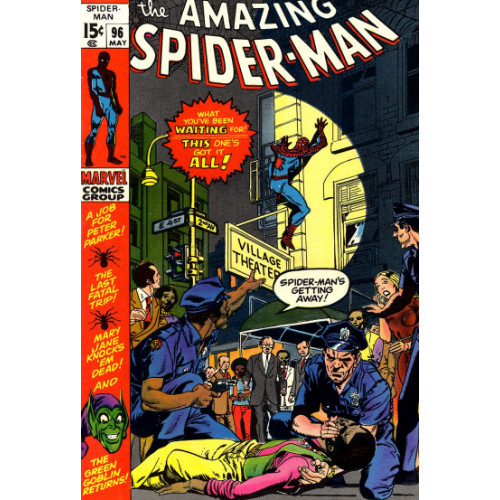
In 1971, fueled by a growing public consciousness about the dangers of drugs, President Richard Nixon announced the "War on Drugs." Among those organizational bodies wanting to use the opportunity to tackle the problem was the U.S. Department of Health, Education, and Welfare, who approached Stan Lee at Marvel Comics about publishing a story addressing the drug epidemic. Lee accepted the project, seeing it as an opportunity for Marvel to encourage its young readership, but ran into a problem: the Comics Code Authority, a body governing proper, publishable content in comic books. Drug depiction was a big no-no for the Code and so denied Marvel's request to publish an anti-drug narrative in three consecutive issues of Amazing Spider-Man.
Stan Lee, unruffled yet adamant about the story's importance, convinced publisher Archie Goodman to publish the story without the Code's approval. Thus, Amazing Spider-Man #96, #97, and #98 became the first-ever Marvel issues to not feature that little "Approved By The Comics Code Authority" box in the front cover's upper right corner. There is much which can be said about the impact of that decision, as Lee and Goodman's challenging of the Authority paved the way for changes made to the Code itself, but as historically influential as those decisions were, we're not here to focus on them.
Yes, folks do drugs in these issues, and we'll talk about that accordingly. But I'd rather spend a good chunk of time on a green guy who experienced his own pains from mind-altering chemicals…not pills or needles, but a crooked little serum which doesn't want to release it grip on the brain of one Norman Osborn.
"...And Now the Goblin"/"In the Grip of the Goblin"/"The Goblin’s Last Gasp"
Writer: Stan Lee
Penciler: Gil Kane
Inkers: John Romita, Frank Giacoia
Colorist: Uncredited
Letterers: Artie Simek, Sam Rosen, Tony Mortellaro
Issues: Amazing Spider-Man #96-98
Issue Publication Dates: May 1971-July 1971
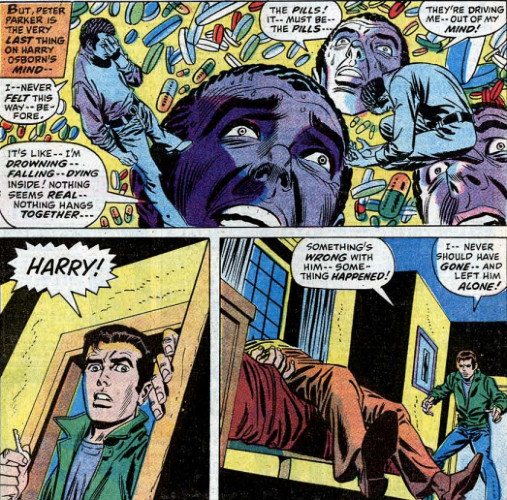
We're jumping a little over fifty issues since the spider and goblin last tussled in the pages of Amazing Spider-Man and nearly three years since the duo fought in Spectacular Spider-Man Magazine #2. Norman Osborn, thanks to some bouts of amnesia, has totally forgotten he was once the Green Goblin…and, thankfully, also totally forgotten that his arch-nemesis is his son's best friend and roommate. But that doesn't mean Peter’s life has been any less hectic: as this trilogy's first issue opens, Peter lands back in New York after looking for his girlfriend Gwen Stacy in London after the young woman absconded following the death of her father. No luck on that end for our young romantic, at least not as this story begins.
Let's gloss over the summary stuff: things go wrong in these issues, okay? Norman remembers, yet again, that he's the Green Goblin, and he and Spidey hash it out across a few battles. In the years since their last fateful encounters, Lee has (in my opinion) developed a somewhat more fluent form of writing which allows Norman's arc of remembrance to feel subtler than his last appearance. Lee cleverly weaves in some drama as Norman's memories begin to surface, injecting the three issues with constant "looking over your shoulder" tension as Peter tries to navigate his regular life and Spidey's problems knowing the Goblin–the one villain who knows the face under the Spider-Man mask–could pop out at any moment like an evil jack-in-the-box.
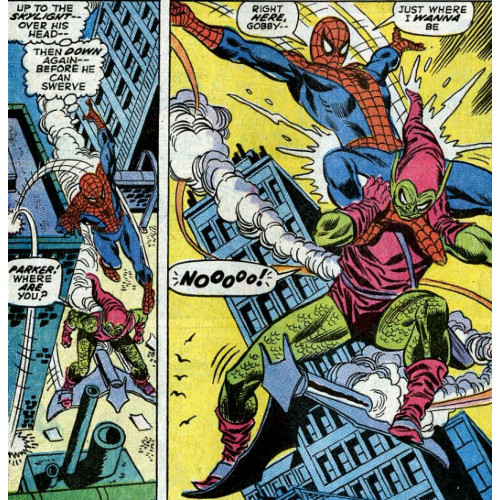
The Goblin serves as the perfect villain for these issues, not only because he raises the personal stakes for Peter dramatically, but because Lee finds a great way to embroil the Goblin in the narrative's drug plot: Harry himself is presented as an addict, with Lee smoothly interjecting Harry's prior frustrations into these issues as the impetus behind his addiction. I don't know if Lee, aware of this upcoming story, clued readers in to Harry's pill-popping problem previously. When Peter confronts Harry in one scene and mentions to himself how his roommate's "always had a lot of bottles in his medicine chest," I couldn't tell you if that statement was precluded by panels of pills in Harry's possession. But Harry's addiction, though perhaps sudden in these issues, feels introduced fairly naturally, predicated on his frustrations over his relationship with Mary Jane Watson and tensions with Peter. So when the Goblin is eventually confronted with his son's problem, Lee's been building the tension for at least two issues. It works rather seamlessly.
I expected, having little to no recollection of these issues, Lee's message to be heavy-handed and preachy, harping on how drugs are bad and how the youth are harming themselves with pills, etc. The message ends up far less stilted than I would have given Lee credit for, confined primarily to the narrative Lee is unfolding. Spidey saving a whacked-out addict feels proper for a Spider-Man comic, and the scene doesn't unnecessarily linger on the drug problem to feel unwelcome. Two scenes featuring Robbie and Randy Robertson feel like Lee stressing how universal the drug problem is, not just limited to one race, undercutting any potential prejudices readers may come into the story with; Randy's scene, in fact, is nicely bookended with Robbie's, perhaps Lee's way of nodding to strong principals within the Robertson family.
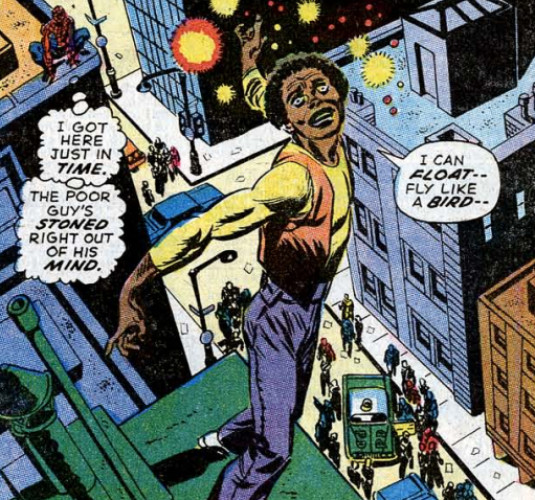
Knowing the whole "a governmental department asked Lee to write this story" piece does lend the issues the context necessary for you to be purposefully watching out for the anti-drug message, but for any reader entering this narrative blind, you wouldn't find yourself caught up in jargon and proselytizing pushing this message down your throat instead of tiny tablets. If you're aware of the message, a moment like where Peter Parker harps on the drug scene may feel a tad superfluous, but these issues otherwise handle the problem well. They emphasize the enormity of the problem and the steps which can be taken by those who can take them, somewhat similar to how Dennis O'Neil and Neal Adams addressed drug addiction and other societal concerns in Green Lantern/Green Arrow.
Instead of offering ham-fisted solutions or nice sounding platitudes, the issues suggest rather than demand–there's a "We're all responsible for handling this problem" vibe without Lee ever telling us we're all responsible for handling the problem or doing more than making a light mention or two as to how we as a society can solve the matter at hand. There's a suggestion, voiced by the Robertsons, that those with the power to enact change should–in this case, Norman Osborn and J. Jonah Jameson–but Lee doesn't double down on any "Rich people should take care of all the problems" rhetoric.
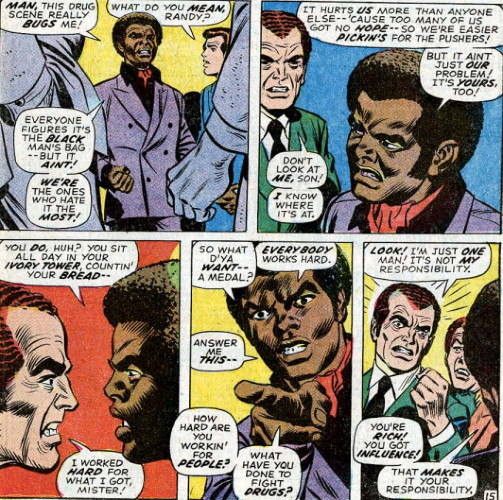

The well-written theming means Lee doesn't skimp on the weight of the story itself. Poor Peter isn't only dealing with the return of the Green Goblin and the frustrations of a roommate hooked on pills, he's working through some struggles with Gwen too. She's never far from his mind even though she's physically distant from New York. "Identity" sums up most of Peter's problems here–Gwen is in London because she blames Spider-Man for the death of her father; Peter is concerned over the Goblin exposing him once Norman remembers Spider-Man's identity, especially once he accepts a job working for (the then-amnesiac) Norman Osborn; and Harry's own sense of worth is exploited by a drug-peddling fiend who gets him hooked on the pills which causes a rift between the roommates. Lee juggles all these pieces well, allowing the narrative heft to carry along the larger theming.
As a character, Spidey has always relied on writers finding that balance between Peter Parker and his costumed alter ego…and the imbalance which comes with Peter playing both roles, seeing where they crisscross and bleed into each other. A scene where Spidey uses Harry to try and shock the Green Goblin back to his senses brings those lines together, as is a sequence where plainclothes Peter takes out a crew of pushers. The conflict is always present, and here, it feels far more natural than Lee's previously forced attempts at developing tension. The problem isn't just, for example, that Peter can't tell Aunt May he's Spider-Man because he thinks she'll suffer a heart attack; the problem is that he accepted a job with an employer whose alter ego wants to kill him because he's Spider-Man…a much graver position to be in with Norman than May.
Though, to be fair, May did shoot at him that one time…

Something I noticed in Spectacular Spider-Man Magazine #2 that also appears here is Peter genuinely wrestling with how to handle the Goblin situation. Lee allows him good moments to grapple with the problem while also empathizing with Norman's plight. Peter's concerns go from "Norman's just crazy" to "Norman possesses a divided personality he doesn't completely control." There's a nice complexity to how Peter considers the weight of Norman's mental health, especially as he knows there's more at stake than just a goon who knows his identity…and that's before you toss in the whole "Harry's hooked on drugs" layer.
Gil Kane provides the pencils on this trilogy, and his style feels more evident in the second and third chapters. Perhaps it’s because John Romita inks the first issue, but Kane's work in this inaugural section feels most like Romita's–his Peter looks like Romita's version of the character, as do Kane's Green Goblin and Mary Jane. It's the latter two issues where Kane's pencils take on a more distinct look–his Goblin, specifically, takes on a wonderfully menacing appearance, and he etches worry well onto the face of a wigged-out Harry Osborn. A panel where Harry enters a darkened room to lie down hits the reader with the weight of that moment–the light from the room Harry enters from is limited in its scope as Harry himself is shrouded in shadow, the darkness a visceral representation of the addiction bearing down on him. You just know he won't be getting the rest he craves.
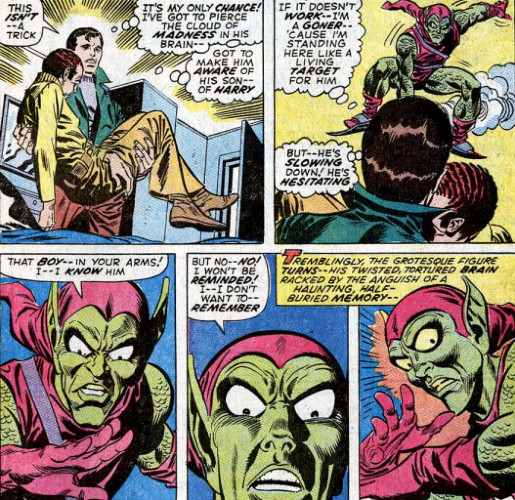
There's a line this trilogy walks carefully, dividing "What could have been" from "What is." The story that "could have been" would have either taken its subject matter too carefully and spoon fed fans candy-coated platitudes or been far too serious and rammed the message down our throats. The comic that "is" chooses a wiser route, channeling its message through characters readers have grown to love and fueling the next chapter in a long-running enmity between a popular hero and villain. The anti-drug message never becomes lost in between the fisticuffs, nor does the conflict buckle under the weight of a story commissioned by the U.S. Department of Health, Education, and Welfare. We're not forced to hear meaningless diatribes intended to provoke; we are asked to empathize with a few characters who face the consequences of their choices…and made to wonder, given similar choices, how we would decide.